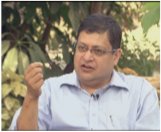Contribute
| In Conversation With Anjan Mukherjee |
Ranjani Saigal
11/09/2009
Anjan Mukherjee is a techno commercial professional with more than two & half decades of combined experience in engineering, sales, consultancy and general management. Previously he was the India representative of a Norwegian multinational, has sailed on merchant ships as chief engineer, co-authored a seminal technical book and has a pending patent. He is a member of the Planning & Academic Board of the Indian Maritime University.
He is the founder and CEO of HyCA technologies.
What motivated you to start HyCA technologies?
It all started with the ballast water treatment problem. When a ship goes from one place to another without cargo, it fills itself up with "ballast water" to give it stability. When it then takes in the cargo at the next port, this water is pumped out. Unfortunately, the water has microorganisms and being alien to the new place is more hard working than the locals(:-)), destroys coral reefs, endangers the local fishing industry, imbalancing the eco system. To combat this menace, an International Maritime Organisation regulation is under way where the ballast water has to be treated on board ship before discharge so that the microorganisms are rendered inactive or killed.
Being a marine engineer, this problem sort of got me hooked. I started researching various technologies, one thing led to another, and hydrodynamic cavitation seemed ideal for solving this. I met my present partner in the company and world renowned expert in cavitation, Dr AB Pandit and we realised that our value system is the same and our skill sets are complementary... we decided to incorporate HyCa.
Can you describe the core technology?
Inside a fluid or slurry when the ambient pressure becomes lower than the saturated vapour pressure, cavitation bubble is formed. When this bubble collapses, the localised temperature is about 10,000 deg centigrade, which is the temperature of the sun, pressure is about 5000 bars and huge turbulence is created. Because of all this highly reactive free radicals are formed. A combination of all this can be manipulated to bring about useful physical, chemical and biological transformations.
We know how to modulate these bubbles in our reactor, HyCator, in a most energy efficient way
What are the different applications for your technology and how easy is it to apply it to different applications?
We already have a few products... HyCator: BFP for prevention of biofouling in cooling towers, HyCator: MBD for molecular breakdown, HyCator: OLM for online mixing without the use of agitators and tanks, HyCator:DOB, for disintegration of bio mass etc These equipments are very easy to use as it could be integrated with any technology & retrofitted into any system by just chopping a piece of the pipeline carrying the fluid. This reduces chemicals usage, saves water, speeds up processing time, saves energy… HyCator™ can handle large flows, is low cost and is highly effective improving the efficiency manifold.
It is exciting the research being done within India itself. Can you comment on the research ecosystem in India ?
We are very small to comment on such macro issues. Our personal experience has been that great researchers are there in many institutions, but what is lacking is the end to end ecosystem to take the research to the market in the form of products. A research which cannot be used is quite pointless.
Are there opportunities for collaboration from people in the New England area?
Absolutely....The Boston area is an innovation hub with smart people who know how to take research work to the market. We would be thrilled to work with them.
Thank you for your time.
Thank you
You may also access this article through our web-site http://www.lokvani.com/
